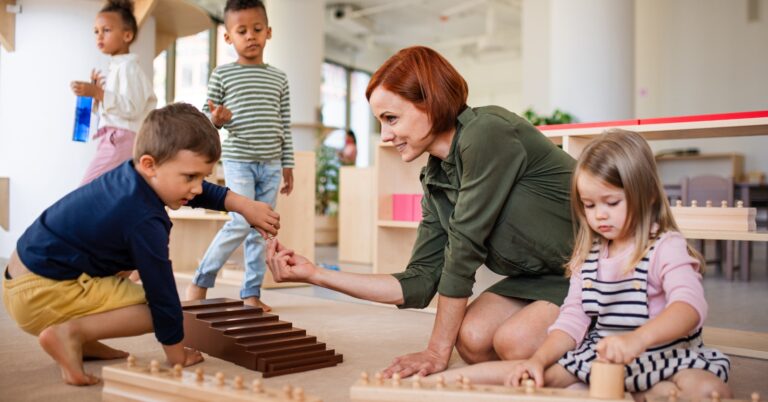It’s amazing to think that your little one, cooing and babbling in their crib, is actually on a fast track to learning language.
Yes, those cute sounds are the beginnings of your baby’s journey towards communication. As a parent, you have an important role to play in supporting this development.
But don’t worry, it’s not about intense ‘baby boot-camps’. It’s about creating a nurturing environment that encourages your baby’s natural curiosity and love for learning.
In this article, you’ll discover 8 simple and effective ways to promote language development in your newborn. Because let’s face it, there’s nothing more exciting than hearing your little one utter their first words.
1. Create a Language-Rich Environment
From the moment your newborn enters the world, they are constantly absorbing information. One of the most effective strategies to promote language development is to immerse your baby in a language-rich environment.
This can be achieved by narrating your daily activities, describing what you’re doing, what you see around you, or even what you’re thinking. This consistent exposure to language helps your newborn understand the concept of communication.
Reading books to your newborn is another excellent way to create a language-rich environment. Even though they may not understand the words, hearing your voice and the different sounds helps familiarize them with the rhythm and tone of language.
Furthermore, singing songs or reciting nursery rhymes can also benefit your newborn’s language development. The rhythm and repetition in these activities can make it easier for your baby to pick up language patterns.
Incorporating these practices into your daily routine can significantly enhance your newborn’s exposure to language, laying a solid foundation for their linguistic development.
2. Respond to Your Newborn’s Attempts at Communication
Just as important as immersing your newborn in a language-rich environment is responding to their attempts at communication. This interaction fosters a sense of engagement and encourages your baby to continue expressing themselves.
In the early stages, this communication might not be through words. It could be through coos, gurgles, or even facial expressions. Regardless of the form it takes, it’s essential to acknowledge and respond to these attempts.
You can respond by mimicking their sounds or expressions. This not only validates their efforts but also teaches them the basics of conversation – that communication involves both speaking and listening.
Another effective way to encourage communication is by using what is known as ‘parentese’ or ‘motherese’. This is a form of speech characterized by a higher pitch, exaggerated intonation, and clear pronunciation.
By actively responding to your newborn’s attempts at communication, you’re fostering an interactive environment that promotes language development.
3. Use Body Language and Gestures
Communication isn’t limited to spoken words. Body language and gestures play a significant role in conveying meaning and can be beneficial for your newborn’s language development.
Even before they begin to speak, babies can understand and respond to non-verbal cues. By using gestures, such as pointing to objects or using your hands to express meaning, you’re helping your newborn associate actions with words.
When you say the word ‘wave’, you could simultaneously wave your hand. This association of the word with the action helps your baby understand the meaning of the word more quickly.
It’s also important to be responsive to your baby’s body language. If they reach out their hands towards you, respond by holding them, reinforcing the understanding that their actions have meaning and can elicit a response.
4. Employ Repetition in Language Learning
Repetition is a powerful tool in language learning. By repeating words or phrases, you’re giving your newborn the opportunity to familiarize themselves with the sounds and rhythms of language.
This doesn’t mean you need to repeat the same word incessantly. Instead, try to naturally incorporate repeated language into your daily interactions. For example, while dressing your baby, you could say, “Let’s put on your socks. One sock on. Now the other sock.”
Songs and nursery rhymes are also excellent vehicles for repetition. The repetitive patterns in these songs can make it easier for your newborn to anticipate and learn language structures.
Repetition should never feel forced or monotonous. The goal is to create a fun and engaging atmosphere where language learning happens naturally.
5. Dedicate Quality One-on-One Time
Dedicating quality one-on-one time with your newborn is a valuable strategy for language development. This uninterrupted time allows you to focus solely on your baby and engage in meaningful interactions.
During these moments, you can talk, sing, or read to your baby without any distractions. The more words your baby hears, the better their language skills will develop.
It’s not just about the quantity of words but also the quality of the interaction. Your tone, facial expressions, and gestures all contribute to your baby’s understanding of communication.
This one-on-one time also strengthens your bond with your newborn, which plays a significant role in their emotional and social development.
6. Limit Background Noise
When it comes to promoting language development in your newborn, the quality of the auditory environment matters. Excessive background noise can interfere with your baby’s ability to focus on your voice and learn from it.
Loud TVs, radios, or even noisy household appliances can drown out your voice, making it harder for your newborn to distinguish and learn sounds.
Therefore, try to minimize background noise when you’re interacting with your baby. This doesn’t mean you need complete silence. Natural sounds, such as the hum of a fan or the chirping of birds, can be soothing and won’t interfere with language learning.
By providing a quiet environment, you’re enhancing your baby’s ability to focus on your voice and pick up on the nuances of language.
7. Incorporate Play into Language Learning
Playtime is more than just fun for your newborn; it’s a valuable opportunity for language learning. When you play with your baby, you’re engaging them in a dynamic, interactive environment that is rich with learning opportunities.
Toys can be great tools for language development. As you play with different toys, describe them to your baby. For instance, while playing with a ball, you could say, “Look at the round, red ball.”
You can also use playtime to introduce your baby to action words. When you bounce the ball, you could say, “The ball is bouncing,” thereby associating the action with the word.
An additional effective approach during playtime is role-playing. Using soft toys or puppets, you can create simple dialogues and scenarios that expose your baby to conversational language.
8. Maintain a Positive and Patient Attitude
Language development is a gradual process. As parents, maintaining a positive and patient attitude is vital for your baby’s language learning journey.
It’s crucial to keep in mind that every baby develops at their own pace. Comparing your baby’s progress with others can be discouraging and unproductive. Focus on your baby’s individual growth and celebrate their unique milestones.
A positive attitude can significantly influence your baby’s learning. When you respond to your baby’s attempts at communication with enthusiasm and joy, you’re encouraging them to continue exploring language.
Patience is equally important. There may be times when your baby seems unresponsive or uninterested in your language-promoting activities. Don’t be disheartened. Be patient and consistent in your efforts.
Embracing the Journey of Language Development
Promoting language development in your newborn is a journey – one that’s filled with joy, challenges, and rewarding milestones. As you embark on this journey, remember that you’re not alone. There’s a vast network of professionals and resources available to support you and your baby.
Every interaction with your newborn, no matter how small, is an opportunity for learning. Your words, gestures, and expressions all contribute to building their understanding of communication. And although this might seem daunting, you’re already equipped with the most important tool: your loving presence.
At the heart of this process is the connection between you and your baby. Through your interactions, you’re not only promoting language development but also nurturing a bond that will last a lifetime.
As you implement these strategies, remember to be patient with yourself and your newborn. Every baby develops at their own pace, and every day brings new opportunities for learning and growth.
At Careful Parents, we believe in empowering parents with practical, research-backed strategies to support their children’s development. We hope this guide serves as a useful starting point in your journey of promoting language development in your newborn. You’re doing an incredible job – keep going!








